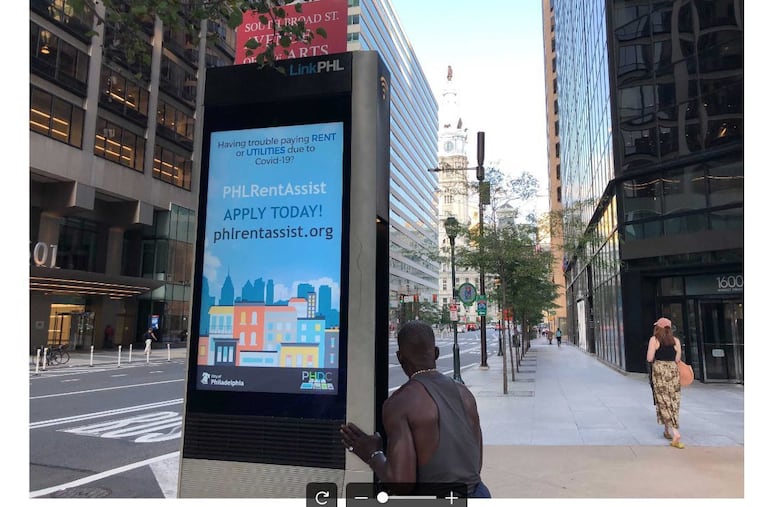Philadelphia’s eviction diversion program became a national model. What’s next as COVID-19 relief funds run out? | Editorial
The city has recorded historically low levels of evictions during the pandemic. The challenge now? Maintaining that trend.

While many cities, counties, and states around the country are struggling to get federal rental assistance dollars to the tenants and landlords who need it, Philadelphia is having the opposite problem — money is starting to run out.
Evictions can have devastating consequences — both for individual households and entire neighborhoods; they also disproportionately affect Black women with children. The pandemic is hardly over, but it’s not too soon to start planning for how Philadelphia can keep its historically low levels of evictions once the crisis abates.
» READ MORE: More than 45,000 Philly tenants have requested help with rent. The city can help less than half.
The Emergency Rental Assistance program has been established by Congress in two waves: the Coronavirus Aid, Relief, and Economic Security Act provided $25 billion and the American Rescue Plan provided up to $21.6 billion to assist those unable to pay rent or utilities. Philadelphia received $47.2 million in the first wave and $23.4 million in the second. In addition, Philadelphia received $40.1 million from Pennsylvania’s portion of a rental assistance fund in the coronavirus relief act.
On Wednesday, both the U.S. Department of Treasury and the White House issued new guidance to make it easier for cities, states, and territories that received rental assistance dollars to get money to landlords and tenants who are in need.
Getting money out the door is not a problem for Philadelphia. The PHLRentAssist program, which has been providing rental assistance since May 2020, opened its Phase 4 applications using Emergency Rental Assistance program funds on April 1. Since then, according to the program’s data dashboard, the city has disbursed more than $85 million through Aug. 20 — helping more than 11,000 households.
That figure, though, reflects only a portion of the need. PHLRentAssist receives 3,000 applications and assists about 900 households a week. At this rate, the $42.5 million that remains will run out in less than two months.
» READ MORE: Philly may have just revolutionized evictions | Editorial
What’s made Philadelphia’s rental assistance efforts so distinctive is the way that they’ve been coupled with the Philadelphia Eviction Diversion Program. Enacted by City Council in June 2020, the diversion program created an avenue for landlords and tenants to resolve disputes outside of court. In April, the Philadelphia Municipal Court revolutionized evictions in Philadelphia by requiring that landlords apply for rental assistance and go through the diversion program before filing an eviction. In a June letter to courts nationwide, the U.S. Department of Justice praised Philadelphia’s diversion program as a model.
“As long as there is funding available and a way to make landlords whole, there is a way to prevent evictions,” Gregory Heller, who oversees PHLRentAssist at the Philadelphia Housing Development Corporation, told this board — “but that all goes out the window if funding isn’t available.”
There is a short-term band-aid: reallocation.
On Sept. 30, the U.S. Treasury will start a reallocation process for some of the Emergency Rental Assistance dollars from places that aren’t spending it. There is no timeline for the process. When reallocation does happen, it will be up to the Philadelphia-area representatives in Congress to ensure that the city gets more money to meet what is still an intense need.
A spokesperson for the Treasury Department told this board: “Treasury is closely monitoring all programs, including those who are not making sufficient progress in delivering assistance and those who have been so successful that they have already distributed a considerable portion of their funds.”
» READ MORE: Philly Municipal Court halts evictions for some who have applied for rental assistance
To sustain the city’s historically low eviction rate, and ensure the routine resolution of landlord-tenant disputes outside of court, Philadelphia’s representatives in Washington, Harrisburg, and City Hall should all be making the case that rental assistance is worth funding even when the pandemic passes. Advocating for a continuous revenue stream could be transformative for the city. In addition, officials need to continue their work to make housing more affordable and ensure renter protections. Continuing to fund right-to-counsel, enforcing the newly passed tenant screening ordinance, and pushing toward inclusionary zoning to ensure more affordable development will all reduce the number of evictions — and the amount of need.
Not that long ago, Philadelphia had the fourth-highest number of evictions of any city in the country. Since the beginning of the pandemic, fewer evictions were filed in Philly than in at least 18 other cities. It is possible to make this the new normal.